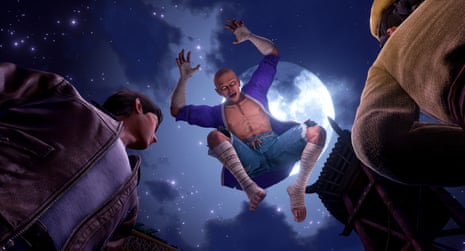For a moment in 1999, Shenmue represented the future of all video games. And in some ways, Sega’s grand murder mystery, set in late-80s Japan, has defined the medium. With a reported budget of $20m and a supporting battalion of artists, designers and programmers, it was the first game to show that video-game publishers could make financial wagers at Hollywood blockbuster-scale. Likewise, Shenmue’s star director, Yu Suzuki, then in his early 40s, laid a template that has defined the games that dominate today’s charts: a living virtual city filled with diversions and populated by AI-controlled characters that worked to daily routines; shops that opened to defined schedules; a world that strained at the seams of its technological circumstance.
Still, while Shenmue came with a cinematic plot – you play as a young Japanese man, Ryo Hazuki, trying to disentangle the threads of his father’s murder – its slow-burn rhythm was almost art-house in pace. Suzuki later said his aim was to replicate not realism, but reality, with all of its periods of listlessness and boredom. As such, the game was filled with daily chores, repetitious part-time work, all the stuff that, ostensibly, people play video games to escape. The gamble did not pay off. Only two of the planned six instalments in the series were released. Grand Theft Auto 3’s arrival in 2001, with its cinematic set pieces and celebrity voice actors, changed the arc of video game design, probably inevitably. The market decided Shenmue’s vision of the future was too quirky, and consequently the murder of Ryo’s father went unresolved.
Until now. Thanks to the rickety miracle of crowdfunding, Suzuki has been able to rally a sufficient number of invested fans (the game immediately became the highest-funded yet on Kickstarter) to continue the story. Twenty years on, Shenmue’s third entry arrives, not as a future-defining vision, but as a relic of a lost era, complete with low-polygon 3D models and straight-to-DVD acting. There’s more here than mere nostalgic allure for the middle-aged, however. The unhurried storytelling and orthodox detective work – virtual hours of chatting to villagers in search of leads, and rifling through musty drawers – has an honest, if, for the contemporary player, initially jarring appeal. If anything, the pacing has slowed further still. Shenmue 3 opens in rural China, where water is drawn from a well, fish are caught from a river, and the evening entertainment consists of placing bets on where a dropped ball-bearing might land. Yes, there are occasional fisticuffs (training Ryo in the local dojo to improve his fighting skills is the most video-gamey this gets), but the dominant tone is one of unhurried investigation. Submit to the spell and the effect is beguiling.
At the time of Shenmue’s original release, it was understood that video games offered an escape from the boredom of reality. In more recent years, the success of myriad games in which players are invited to engage in, essentially, virtual work – Car Mechanic Simulator, Farming Simulator, Euro Truck Simulator, and so on – has demonstrated that our relationship with games is more complicated. There is, it seems, a certain comfort in routine. In Shenmue 3 that monotony is forcefully present. Ryo has a stamina gauge that depletes with time, and you’ll need to buy food to keep his strength up. This means taking on part-time work such as chopping wood for a local shopkeeper, picking and selling herbs, or, if you prefer to gamble, buying capsule toys in the hope of winning a rare item that might be pawned.
A game out of its time, out of fashion, Shenmue 3 is nevertheless more than a mere curio. It proves once again that when a big-budget video game can admit that it’s not a film, magic can be found in the everyday tedium of life between the highlights.
Also recommended
Card of Darkness
(Zach Gage, Apple Arcade)
Apple’s nascent subscription game service, which provides access to scores of games for a modest monthly payment, is already filled with gems. Card of Darkness, the latest from Zach Gage (SpellTower, TypeShift etc.), with art by Adventure Time creator Pendleton Ward, is one of the brightest, a puzzle card game masquerading as a Tolkienesque adventure, able to chew any commute into a blur. You manoeuvre your character across a 4x4 grid populated with stacks of cards. Some represent enemies, others spells and weapons. Mathematical reasoning and wagering hold the key to progress, while Ward’s characteristic flair for turning blobs into characters softens the tone. The result is joyous.

Comments (…)
Sign in or create your Guardian account to join the discussion